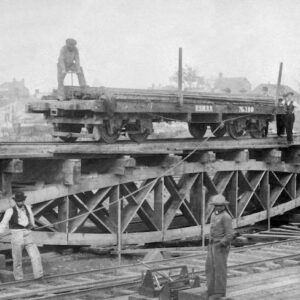| Credit: | by Russell (Andrew J.) |
|---|---|
| Date: | 1863.02-03 |
| Negative Size: | 6.5 in. x 8.5 in. |
| Equipment: | auger; sledgehammer |
| Locations & Lines: | Alexandria VA; Orange & Alexandria Railroad (O&A); Virginia |
| Military Units: | US Military Railroads (USMRR); US Army |
| Sources: | J. Paul Getty Museum; Lehigh University; Library of Congress |
$5.99
File Details: AAAYm, 600 DPI, TIFF, Original Photograph, 17.5 Mb
Image ID: AAAY
Snow on the ground.
Haupt, United States Military Railway Department. Construction And Transportation. No. 24. Experimental Bridge Trusses. – No. 24 represents a truss for military bridges, which is composed of boards nailed and spiked together. The span is 60 feet, the height of truss 6 feet. The form is that of a fish or two arches curved in opposite directions. The lower arch is composed of six boards, the upper arch of five. The braces are of two inch plank, and through the trusses, vertically, inch bolts are passed. These trusses were tested by forming a bridge of two of them, which was loaded with railroad iron until it broke, the weight was applied by first piling a number of bars on the bridge, then pulling over a car loaded with a twenty tons by means of a rope, so as to avoid risk to the men; the bridge broke with 108,000 lbs.
This was a highly satisfactory experiment, and although the trusses were designed simply for ordinary military bridges, they would safely have carried a locomotive. When they broke, the weight stood on the bridge five minutes before it came down. Much stronger trusses than those experimented upon, can be made by pitching the surfaces of the boards, bolting them with half-inch bolts at intervals of a foot, and driving spikes through at intervals of four inches. Two such trusses would carry a train, but three or four could be used if preferred.
Instead of two arches turned in opposite directions, one of them may be replaced by a straight chord.







